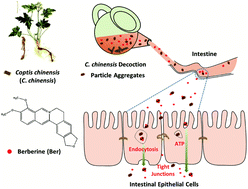Role of particle aggregates in herbal medicine decoction showing they are not useless: considering Coptis chinensis decoction as an example
Abstract
A large number of plants and fungi are homologs of medicine and food, and are used in the form of decoctions for complementary foods, dietary cures, and disease therapy in traditional medicine. Besides the widespread concern around the physiological and pharmacological actions of the active ingredients, the phase change in decoction and its influences on the active ingredients’ absorption should not be ignored. Lots of particle aggregates are generated during the decoction of herbal medicine and then end up being taken together with the active ingredients. The question arises, “Is the absorption of active ingredients associated with the particle aggregates in decoction?” The present study takes the Coptis chinensis decoction (CCD), the particle aggregates in CCD (CCD-Ps), and the water-insoluble active ingredient of Berberine (Ber) as typical examples to investigate the effects of particle aggregates in herbal medicine decoction on the active ingredient absorption in the intestine and the underlying mechanisms. The CCD-Ps are mainly composed of polysaccharide, with commonly features of a hundred-nanometers size and negatively charged. A series of Coptis chinensis polysaccharide (CCP) composed particle aggregates (CCP-Ps) were self-assembled to mimic the CCD-Ps. In situ single-pass intestinal perfusion experiments exhibited that, both the CCD-Ps and CCP-Ps exhibited charge-dependent promotion on Ber absorption in the intestine, through regulating the tight junctions (TJs) between intestinal epithelia cells. Caco-2 cell monolayer model experiments revealed that the particle aggregates not only promoted paracellular Ber transport through TJs regulation but also improved the transcellular Ber transport through active transport and endocytosis. The present study provides a novel viewpoint to explain the scientific implications of herbal medicine decoction, in which the particles aggregated in decoction are not useless but rather act as an effective and important enhancer for adsorption of the active ingredients through multiple mechanisms.



 Please wait while we load your content...
Please wait while we load your content...